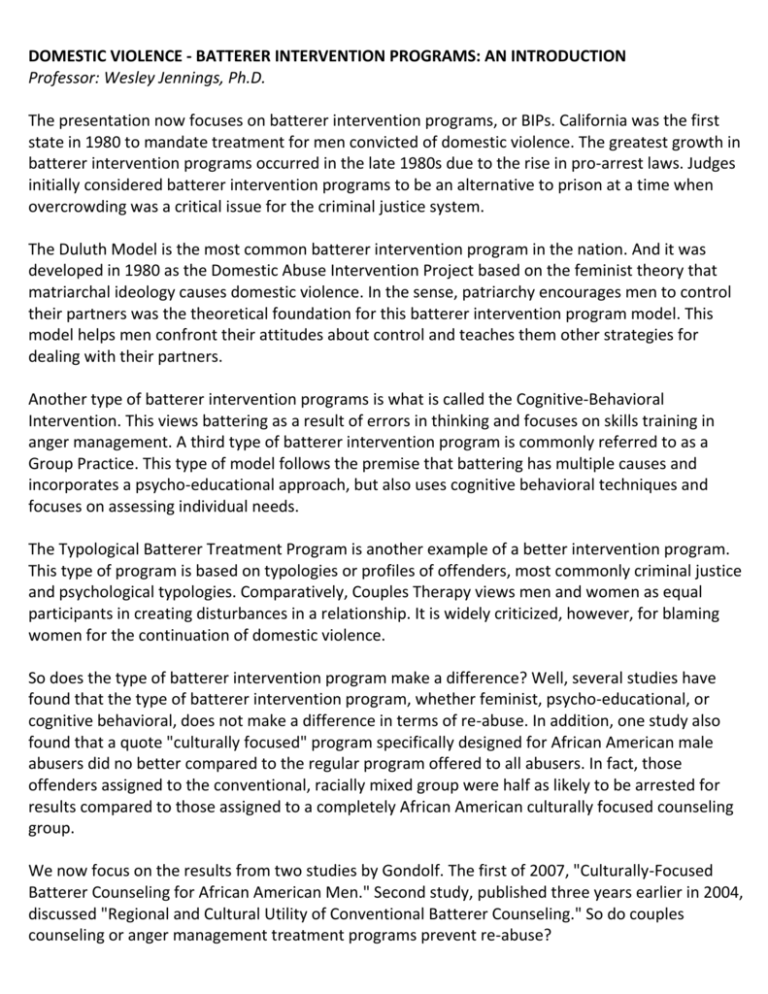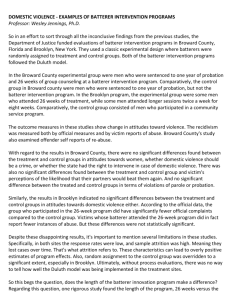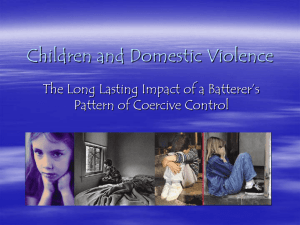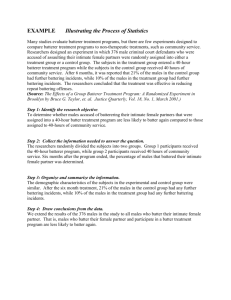The presentation now focuses on batterer intervention programs, or
advertisement

DOMESTIC VIOLENCE - BATTERER INTERVENTION PROGRAMS: AN INTRODUCTION Professor: Wesley Jennings, Ph.D. The presentation now focuses on batterer intervention programs, or BIPs. California was the first state in 1980 to mandate treatment for men convicted of domestic violence. The greatest growth in batterer intervention programs occurred in the late 1980s due to the rise in pro-arrest laws. Judges initially considered batterer intervention programs to be an alternative to prison at a time when overcrowding was a critical issue for the criminal justice system. The Duluth Model is the most common batterer intervention program in the nation. And it was developed in 1980 as the Domestic Abuse Intervention Project based on the feminist theory that matriarchal ideology causes domestic violence. In the sense, patriarchy encourages men to control their partners was the theoretical foundation for this batterer intervention program model. This model helps men confront their attitudes about control and teaches them other strategies for dealing with their partners. Another type of batterer intervention programs is what is called the Cognitive-Behavioral Intervention. This views battering as a result of errors in thinking and focuses on skills training in anger management. A third type of batterer intervention program is commonly referred to as a Group Practice. This type of model follows the premise that battering has multiple causes and incorporates a psycho-educational approach, but also uses cognitive behavioral techniques and focuses on assessing individual needs. The Typological Batterer Treatment Program is another example of a better intervention program. This type of program is based on typologies or profiles of offenders, most commonly criminal justice and psychological typologies. Comparatively, Couples Therapy views men and women as equal participants in creating disturbances in a relationship. It is widely criticized, however, for blaming women for the continuation of domestic violence. So does the type of batterer intervention program make a difference? Well, several studies have found that the type of batterer intervention program, whether feminist, psycho-educational, or cognitive behavioral, does not make a difference in terms of re-abuse. In addition, one study also found that a quote "culturally focused" program specifically designed for African American male abusers did no better compared to the regular program offered to all abusers. In fact, those offenders assigned to the conventional, racially mixed group were half as likely to be arrested for results compared to those assigned to a completely African American culturally focused counseling group. We now focus on the results from two studies by Gondolf. The first of 2007, "Culturally-Focused Batterer Counseling for African American Men." Second study, published three years earlier in 2004, discussed "Regional and Cultural Utility of Conventional Batterer Counseling." So do couples counseling or anger management treatment programs prevent re-abuse? Overall, most batterer treatment standards prohibit couples counseling. There is little recent research on couples counseling involving batterer and their victims, however. While an early study in 1985 found it to be effective, other studies since then have found higher re-abuse rates when programs involve couples counseling or anger management. One study, in fact, suggested that couples counseling after individual counseling for batterer and victims may be safe and beneficial for couples that want to remain together. Comparatively, while anger management is also part of batterer intervention programs based on cognitive psychology, generic anger management programs by themselves, like couples counseling, have been generally prohibited by most state batterer treatment standards. In one of the large studies to date involving a sample of 945 defendants who were arraigned for violating a protection order were ordered into a batterer intervention program, including a certified batterer intervention program, anger management, mental health treatment, and/or substance abuse treatment. This study found that those who were referred to this holistic type of program for 12 to 20 weeks and participated in anger management programs had higher completion rates compared to those who were referred to a much longer 40-week batterer intervention program. However, despite the higher completion rates, there was no difference in the re-arrest rates for those who completed anger management compared to those that failed to complete the anger management component. Furthermore, those who completed anger management recidivated at higher rates than those that completed the batterer intervention program. Even though those referred to the batterer intervention programs had significantly more criminal histories. An earlier study of a program in Pittsburgh found that abusers who relied on anger management control techniques were more likely to re-abuse their partners compared to those who relied on increased empathy, a redefinition of their manhood, and more cooperative decision making as a means to ending their abuse. Overall, there's no evidence that anger management or couples counseling programs effectively prevent court mandated abusers from re-abusing the victims or committing new offenses after the treatment. Overall, there have been more than 35 evaluations of batterer intervention programs. The early studies that use quasi-experimental design consistently found small program effects, but later more methodologically rigorous evaluations yielded inconsistent and disappointing findings. In the sense, treatment effects were very limited to a small reduction in re-offending. Overall, the results from these 35 evaluations remain inconclusive at best regarding the effectiveness of batterer intervention programs. One recent meta-analysis, which is a type of study that combines the effects of these programs together into one quote "overall global effect size" concluded that the effect size due to batterer intervention programs on domestic violence recidivism is in the small range. To a clinician this translates to mean that a woman is 5% less likely to be re-assaulted by a man that is arrested, sanctioned, and went to a batterer intervention program, compared to a man who was simply arrested and sanctioned. In addition, one study of four batterer intervention programs found that approximately 25% of the batterers appeared to be unresponsive and resistant to batterer intervention programs. Nevertheless, it is important to continue evaluating batterer intervention programs so that we make sure we are not making situations worse for people who are trying to help. At this point, the evidence does not suggest that batterer intervention programs are helpful, which potentially suggests that they are harmful. And a few studies have actually found that batterer intervention programs make the abusers more likely to re-abuse.







